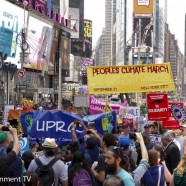How LED Lights Are Helping Address Climate Change
In New York City, 300,000 to 400,000 people recently took to the streets calling for action on climate change. These concerned world citizens would be pleased to note that as we shift away from inefficient incandescent bulbs, those who choose LED lights are helping address climate change by minimizing humanity’s environmental impact.
Electricity production is the single largest contributor to CO2 emissions, accounting for 38% of U.S. emissions from 1990-2012. LEDs help us address climate change by lowering our electricity demand and therefore lowering our CO2 emissions. While installing LED strip lights in your kitchen won’t stop global warming, if you choose to make the investment in LEDs, you’re doing your part to slow its progress.
Here are the top environmental reasons for choosing LEDs over other conventional lighting sources:
Energy Efficiency
High quality LED lights work at 80% efficiency. That means that 80% of the electricity used by an LED chip goes straight into producing light. Compare that to an incandescent bulb, which in many cases is just 20% efficient — 80% of the electricity used is transferred into heat instead of light.
The U.S. Energy Information Administration estimates that in 2012, lighting constituted 17% of the total energy used by homes and businesses in the United States. Switching our lights over to LEDs, making them use electricity with 80% more efficiency, would have a dramatic impact on our CO2 emissions. There are other cases where LEDs will come in handy as well, such as LED refrigerator display lighting and poultry farming, where we can further lower energy demands since cool LED running temperatures require less artificial cooling.
Furthermore, LEDs produce directional light, meaning light isn’t wasted in directions where it isn’t needed.
Less Waste
The typical lifespan of an incandescent bulb is 750 to 1,000 hours. CFLs, which last longer than incandescents, still only last around 25,000 hours, provided they’re deployed under proper conditions using three hour cycles. High quality LED lights far outlast the competition; our LED strip lights, for example, are rated for 50,000 hours of use. In most circumstances, that amounts to well over a decade!
Not only that, but most LEDs are made with nontoxic materials and don’t require the same cumbersome waste management protocols such as mercury-containing CFLs.
Compatibility with Renewables
The rapid development of renewable energy, especially solar, works hand in hand with programmable LED lighting. Solar energy uses the sun’s rays to produce electricity. Due to the many attributes of LEDs, this revolutionary lighting source is preferable for use with solar.
Solar energy is intermittent — it changes based on how much sun is shining — which means it relies on energy storage batteries to operate. LEDs make more efficient use of these expensive batteries because of their intelligent control features, low energy use, rapid on/off switching and full range dimming capabilities. As humanity eventually switches over to solar instead of fossil fuels, that valuable electricity made by direct solar sunlight shouldn’t be wasted on inefficient technologies such as incandescents, but rather maximized to its full potential with LEDs.
Intelligent Controls
One of the greatest advances that LED lighting represents is its ability for intelligent control. LED lights can easily be controlled through digital programming and networked management, making them an even more efficient form of lighting. A new LED bulb released by ex-Tesla and NASA engineers can adjust its light output to the amount of sunlight entering a room, and automatically turn on/off or dim down based on whether or not people are in the room.
In fact, we’re just scratching the surface of what we’ll one day be able to do with LEDs. For that reason, we’re extremely excited here at Flexfire LEDs to be a part of the future of LED lighting.
Questions?
Do you have any more questions about LED lights? We’d love to provide you with expert advice on LED strip lighting possibilities whenever you’re ready.
Contact:
Phone: 1-844-FLEXFIRE (1-844-353-9347)
Email: info@flexfireleds.com
Website: flexfireleds.com











